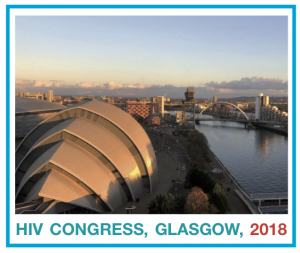Fostemsavir: 48-week phase 3 results from BRIGHTE study
13 November 2018. Related: Conference reports, Antiretrovirals, HIV 14 Glasgow 2018.
 Simon Collins, HIV i-Base
Simon Collins, HIV i-Base
Two oral presentations provided 48-week safety, efficacy and subgroup analysis from the investigational gp120 attachment inhibitor fostemsavir.
As the first drug in a new class, this compound is especially important for people with drug resistance to their current last combination.
Although the primary endpoint was viral suppression to <40 copies/mL at day 8 after fostemsavir has been added to current failing ART, participants have now reached 48-weeks for secondary efficacy and safety endpoints. Other investigational drugs were allowed during the optimisation phase. The data at Glasgow 2018 update the week-24 results presented last years at the EACS 2017 conference.
As previously reported, this was an advanced patient group with CD4 count at screening less than 200 cells/mm3 in 72% and 50 cells/mm3 in 41% of the group. Previous use of integrase inhibitors and protease inhibitors were reported for 80% and 96% respectively.
Baseline characteristics for the randomised group included median age 44 years (range 18 to 73) and approximately 30% were women. Median (range) CD4 and viral load were approximately 100 cells/mm3 (0 to 1160) and 4.7 log copies/mL (1.6 to 6.9), respectively. Approximately 10% had no fully active drugs in the optimised background regimen (OBR), with 40-50% having only 1 or 2 fully active drugs.
Baseline characteristics were similar for the open-label group, with the important exception that 80% had no active drugs in the OBR and 20% had only one active drug. In this group, >95% had integrase experience and 70% had used T-20. Of the 19 people with sensitivity to one drug, 13/19 used the investigational mAb ibalizumab.
By week 24, viral suppression was reported for 54% of participants, with 71% and 77% using <200 and <400 copies/mL cut-offs respectively.
By week 48, follow-up included 79% (215/272) randomised participants and 68% (69/99) open label participants. Reasons for withdrawal are shown in Table 1.
Table 1: Reasons for study withdrawals by week 48
| Randomised | Open label | |
| n=57/272 | n=32/99 | |
| AEs | 9 (3%) | 5 (5%) |
| Lack of efficacy | 12 (4%) | 6 (6%) |
| Non-adherence | 11 (4%) | 5 (5%) |
| Withdrawn consent | 5 (2%) | 1 (1%) |
| Lost to follow-up | 7 (3%) | 1 (1%) |
| No longer met study criteria | 3 (1%) | 2 (2%) |
| Death | 8 (3%) | 12 (12%) |
| Pregnancy | 1 (<1%) | |
| Other | 1 (<1%). |
At week 48, by snapshot analysis, 54% participants in the randomised study (146/272) and 38% (38/99) in the open label study had viral load <40 copies/mL. These were similar to rates at week 24.
Over time, rates were higher by observed analysis: 57% vs 62% <40 copies/mL, 79% vs 84% <200 copies/mL and 85% vs 86% using the <400 copies/mL thresholds – all weeks 24 (n=246) vs 48 (n=233) respectively.
Mean CD4 responses also steadily increased in both groups over 48 weeks by +139 cells/mm3 and +63 cells/mm3 in the randomised and open label groups respectively.
Serious adverse events were common in both arms, reflecting the advanced HIV stage, but were higher in the open label group: 31% vs 44%; grade 3/4: 26% vs 47%; and deaths 4% vs 14%.
The sub group analysis by baseline CD4 count showed significant CD4 increases even for those starting with CD4 counts <20 cells/mm3, although viral response rates were lower for this group (35%).
Table 2: Fostemsavir subgroup analysis by baseline CD4 count
| HIV viral load <40 c/mL | Change in CD4 cells/mm3 | |||
| BL CD4 cells/mm3 | n | n (%) | n | Mean change (SD) |
| 20 | 72 | 25 (35%) | 58 | 145.2 (109.33) |
| 20–50 | 25 | 12 (48%) | 20 | 149.0 (93.20) |
| 50–100 | 39 | 22 (56%) | 30 | 126.4 (103.62) |
| 100–200 | 63 | 37 (59%) | 57 | 123.1 (101.13) |
| ≥200 | 73 | 50 (68%) | 63 | 150.0 (195.88) |
References
Unless stated otherwise, references are the the programme and abstract from the Glasgow 2018 conference. These are available online as a supplement to the Journal of the IAS.
https://onlinelibrary.wiley.com/toc/17582652/2018/21/S8
- Aberg J et al. Week 48 safety and efficacy of the HIV-1 attachment inhibitor prodrug fostemsavir in heavily treatment-experienced participants (BRIGHTE study) . Glasgow HIV Congress 2018, 28 – 31 October 2018. Oral abstract O344A.
- Molina J-M et al. Phase III study of fostemsavir in heavily treatment-experienced HIV-1 infected participants: BRIGHTE Week 48 sub- group analysis in randomised cohort participants .Glasgow HIV Congress 2018, 28 – 31 October 2018. Oral abstract O344B.

